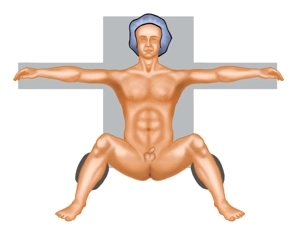- Intermediate transsphincteric fistulas
- High transsphincteric fistulas
- Suprasphincteric fistulas
- Acute abscess with existing fistula that initially cannot be laid open
-
Indications
-
Contraindications
- Patients who are inoperable
Note: Chronic inflammatory bowel disease is not a contraindication for this surgical technique.
-
Preoperative diagnostic work-up
- The necessary diagnostic work-up depends on the underlying problem and the urgency of the acute inflammation. As a rule, no specific examination modalities are required. Possibly helpful in special cases: Anal endosonography, CT or MRI
-
Special preparation
- None
-
Informed consent
General:
- Bleeding
- Thrombosis
- Embolism etc.
Specific:
- Persistent secretion
- Protracted healing
- Long healing period
- Renewed abscess formation
- Usually requiring further surgery
-
Anesthesia
Depending on the general condition of the patient:
- General anesthesia (General anesthesia, Laryngeal mask airway anesthesia)
- Regional anesthesia (Epidural anesthesia, Caudal block)
-
Positioning
![Positioning]()
- Lithotomy position
-
Operating room setup
![Operating room setup]()
- The surgeon sits facing the patient in the lithotomy position, with the first assistant to his/her left. The scrub nurse stands or sits on the right side behind the surgeon.
-
Special instruments and fixation systems
- Various probes (to probe the fistula)
- Possibly toluidine or methylene blue in unclear fistula tracts
-
Postoperative analgesia
Nonsteroidal anti-inflammatory drugs usually suffice; if necessary, they can be enhanced by opioid analgesics.
Follow this link to PROSPECT (Procedures Specific Postoperative Pain Management)
Follow this link to the current German guideline Behandlung akuter perioperativer und posttraumatischer Schmerzen [Treatment of acute perioperative and posttraumatic pain].
Postoperative care:
Loosely pack the external wound with a gauze pad or tamponade at the end of the procedure and remove it on postoperative day 1. In order to keep the wound area reasonably clean, diligent copious irrigation or sitz baths after bowel movement are mandatory.Deep venous thrombosis prophylaxis:
Unless contraindicated, the moderate risk of thromboembolism (surgical operating time > 30 min) calls for prophylactic physical measures and low-molecular-weight heparin, possibly adapted to weight or dispositional risk, until full ambulation is reached.Note: Renal function, HIT II (history, platelet check)
Follow this link to the current German guideline Leitlinie Prophylaxe der venösen Thromboembolie [Guideline on prophylaxis in venous thromboembolism].
Ambulation: Unrestricted, possibly restraint in physical exercise
Physical therapy: Not necessary
Diet: Unrestricted
Bowel movement: Keep stool soft to avoid unnecessary pressing. Best by ingesting enough fiber regularly (e.g. psyllium husks). Rather restrained administration of 20ml lactulose, possibly Movicol, as this may often result in unplanned mushy stools or diarrhea.
Work disability: Depending on the size of the wound: Hospital stay 2-5 days, in some cases also outpatient surgery possible, work disability: 2-6 weeks


